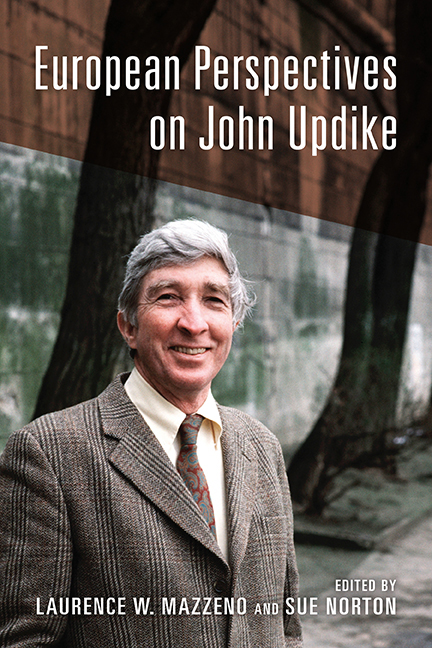Book contents
- Frontmatter
- Contents
- Acknowledgments
- List of Abbreviations
- Introduction: Updike as Europeans See Him
- Part I Coming of Age, Aging in Time
- Part II Love, American Style
- Part III Amazing Grace, American Faith
- Part IV Old World Myths, New World News
- 10 “Hey, Come On, We're All Americans Here”: The Representation of Muslim-American Identity in John Updike's Terrorist
- 11 Intertextual Updike: Gertrude and Claudius
- 12 Rabbit and the News
- Sources for Further Study
- Notes on the Contributors
- Index
10 - “Hey, Come On, We're All Americans Here”: The Representation of Muslim-American Identity in John Updike's Terrorist
from Part IV - Old World Myths, New World News
Published online by Cambridge University Press: 15 August 2018
- Frontmatter
- Contents
- Acknowledgments
- List of Abbreviations
- Introduction: Updike as Europeans See Him
- Part I Coming of Age, Aging in Time
- Part II Love, American Style
- Part III Amazing Grace, American Faith
- Part IV Old World Myths, New World News
- 10 “Hey, Come On, We're All Americans Here”: The Representation of Muslim-American Identity in John Updike's Terrorist
- 11 Intertextual Updike: Gertrude and Claudius
- 12 Rabbit and the News
- Sources for Further Study
- Notes on the Contributors
- Index
Summary
Introduction
IN HIS TWENTY-SECOND NOVEL, Terrorist (2006), John Updike portrays an American high-school boy who grows up in New Prospect, New Jersey, converts himself to Islam at age eleven, and a few years later nearly sacrifices his life for the jihad by planning to detonate a suicide bomb in the Lincoln Tunnel, connecting New Jersey and Manhattan. When almost at the end of the novel, Ahmad's Jewish high-school guidance counselor, Jack Levy, manages to enter the bomb truck and tries to prevent Ahmad from pressing the detonation button, Jack says, “Hey, come on, we're all Americans here. That's the idea, didn't they tell you that at Central High? Irish-Americans, African-Americans, Jewish-Americans; there are even Arab-Americans” (T, 301).
Despite the obvious irony of this statement, Levy is touching upon one of the key issues of the novel: the different cultural backgrounds of the people surrounding Ahmad, who himself embodies both East and West and tries to come to terms with his hybridity. Focusing on Ahmad (Ashmawy) Mulloy and the way he relates to his multicultural environment, this chapter attempts an analysis of the fictional representation of Muslim-American identity, for which John Updike has been heavily criticized.
Terrorist appeared five years after September 11, 2001, and references the tragic World Trade Center attacks like more than one hundred other American novels that have come out since 9/11 (cf. Däwes 2010, 495). The title itself not only points to the protagonist's destiny but also refers to a problem of increasing importance: ever since 9/11 people perceived as Muslim or Arab run an even higher risk of being associated with terrorism. As Mike Davis (2001) points out, “The real burden of the new urban fear—the part that is not hallucinatory or hyperbolized—is borne by those who fit the racial problem of white anxiety: Arab and Muslim Americans…. For those caught squarely in the middle of this paranoid gestalt … there is the threat of violence” (48).
- Type
- Chapter
- Information
- European Perspectives on John Updike , pp. 155 - 165Publisher: Boydell & BrewerPrint publication year: 2018



